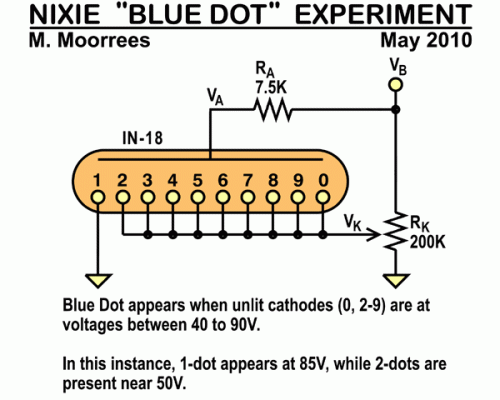The infamous ‘Blue Dot’
Blue Dot experiment
This infamous effect is mostly can be seen on the biggest exUSSR IN-18 Nixie Tubes. Also european big Tubes like ZM1042, Z566 and Z568 suffer from this effect as well. And it appears mostly when displaying number “1”. It manifests as a small glowing blue spot of gas that appears in front of the digit. Sometimes it is also can be seen in other Nixie Tubes, usually in larger ones. At the time when these Tubes were used in instruments and indicators it wasn’t a big of an issue. Displays back there usually had a transparent red plastic filters in front of the Tubes, so the blue glow was filtered and only the red lights came through.
A case for this phenomena can happen when you lit up another, say, NL-841 Nixie Tube. If used as decimal point as the anode this can be resulted:

Since the decimal point made for a very small anode, all the current that makes the digit glow must also pass through it. This means the blue glow happens when the current density exceeds a particular threshold. You can run an experiment for yourself with an IN-18 Nixie Tube and see if you can reproduce the blue dot yourself. Below is an example circuit for it to use:

Many of Nixie Clocks use the 7441 and 74141 or russian equivalent of ICs like k155ID1 to drag the desired cathode to near ground potential (zero volts) to turn it ON. Simple open-collector transistor stages, which have the collectors of the 10 output NPN transistors, tied to their respective Nixie cathode (0-9). The emitters of all 10 transistors are tied to ground. Some simple logic turns ON only one of these transistors at a time, which allows the selected cathode current to flow to ground. The remaining 9 OFF cathodes, an connected transistors float to some random voltage. Ideally they should go up to the anodes voltage, so the voltage difference between the anode and OFF cathodes is zero. Fortunately, there needs to a significant voltage difference between the anode and cathode, for current to flow, for it to glow. Usually between 130 and 150V. That means if the supply is 170V, then cathode only needs to rise to 40V (170V–130V), to stay OFF. Nixie driver ICs back then usually had zener clamps around 65V, because high voltage transistors did not exist at the time or were economically impractical to use.
But the described in this article experiment shows that even though, the OFF cathodes, stayed off, they still drew a small amount of current. This altered the current flow pattern inside the IN-18 Nixie Tubes, changing the current density, in all areas of the Tube. And most notably when the number “1” is lit. It makes a narrow current channel to the anode, and the OFF cathodes may be acting as beam forming plates, as in beam power Tubes, like the 6L6.
Here you can see the results of varying the OFF cathode voltage, Vk:



As you can see the blue dot can be created at will. More so, the lower the voltage is, on the OFF cathodes (Vk). The solution for eliminating this effect is very simple. You need to use cathode driver transistors that can rise to above 90V. Nowadays common transistors like the MPSA42 and 2N6517 will do that job. Also it is worth to mention that you need to make sure your mid-pull voltage is between 90 to 110V.
Gra & Afch Nixie Tubes Clocks
Our Nixie Tubes Clocks here at Gra & Afch assembled according to the modern scheme with direct control of the Tubes and based on two IC registers HV5122PJ have no problems with “blue glow” dots and low level of Tubes brightness. More details about the types of IC drivers you can find in our Article on this matter. For large Nixie Tubes such as IN-18, Z5660M, ZM1042, Z568 we use a drivers with an open collectors (open-collector) or open-drain outputs to work. That is, those in which one of the output states is a logical zero, and the second is a Z-state. It is also worth to mention that modern IC registers like HV5122PJ don’t have least voltages and resistance through internal transistor is as maximum as possible and the current is not flowing when closed.
You can look for our Ready-to-Use Nixie Tubes Clocks and DIY KITs in our sections: Nixie Clocks in Cases, Nixie Clocks without Cases, DIY KITs for Nixie Clocks.

